
When competition for new markets and customers increases, the level of customer satisfaction becomes a key factor for long-term business success. Satisfied customers often become loyal customers and help to ensure future cash flow. In their article “Zero Defections: Quality Comes to Services” (Harvard Business Review, 1990) F.F. Reichfeld and W.E. Sasser report that a 5 percent increase in customer loyalty can increase profit by 100 percent due to the fact that satisfied customers purchase the company’s products more often and in greater quantities. In general, satisfied customers are less price-sensitive and more inclined to spend more on proven products.
Considering customer satisfaction levels when creating a product is not an easy process. Many Six Sigma practitioners use the quality function deployment (QFD) tool to translate the voice of the customer (VOC) into product specifications. QFD offers a customer-oriented approach, supporting design teams in developing new products based on an assessment of customer needs. Customer needs are translated into design attributes, which are then deployed in process and quality requirements.
Benefits derived from using the QFD tool include:
- The creation of work teams that include multiple skills and experiences
- The determination of specific work aims
- A display of a wide variety of important design information in one place in a compact form
- Reduced overall costs from realizing a reduction in design changes
- Reduced production costs by eliminating redundant features and over-design
What Is QFD?
QFD is composed of four stages:
- Complete the house of quality (HOQ).
- Design the product – Determine tolerance of each part of the product so that it satisfies the target value identified from the HOQ.
- Design the process – Determine the necessary production process that will satisfy tolerances established during product design.
- Control the process – Determine quality standards for the new product design.
Many companies think QFD is composed of simply the first stage; however, all stages are important to the successful development of the product. This article focuses heavily on the first stage because of its importance, but practitioners should remember that this is not the only part of the approach.
Completing the House of Quality
The house of quality is a diagram used to capture, summarize and display detailed information (Figure 1).
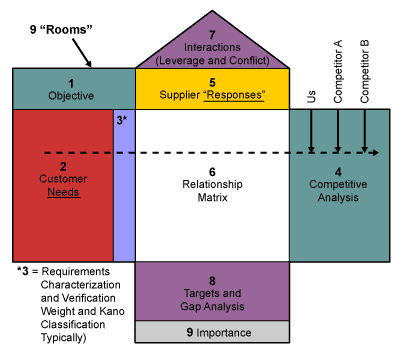
Step 1: Customer Requirements and Needs
This section, Room 2 of the HOQ shown in Figure 1, is sometimes completed by the marketing department because of its relationship with customers, although other areas of the company with customer touch points also may contribute. The information contained in this section represents the VOC and is obtained from various sources such as:
- Searching the market for industry standards
- Surveying customers
- Analyzing customer complaints
The Kano model of customer satisfaction is a useful tool to help determine attractive or must-be customer requirements. Results from the Kano survey feed the customer requirements and needs section of the HOQ matrix.
Kano Model of Customer Satisfaction
The Kano model (Kano, 1984) distinguishes between three types of product or service requirements that influence customer satisfaction (Figure 2):
- Must-be requirements – These represent the basic criteria for a product as determined by customers. If these requirements are not present or are insufficient, customers are extremely dissatisfied. On the other hand, if these requirements are present or sufficient, they do not bring satisfaction. In fact, customers see these requirements as prerequisites. For example, if a restaurant is very clean, it will not bring additional satisfaction to the customer because cleanliness is regarded as a must-be requirement. If a restaurant does not meet the minimum requirement for cleanliness, customers will not go to that restaurant at all. Customers usually do not explicitly demand must-be requirements.
- One-dimensional requirements – Customer satisfaction is proportional to the level of requirements fulfilled. The higher the level of fulfillment, the higher the customer satisfaction. For example, for a given model of car, the higher the mileage per gallon, the higher the customer satisfaction. If the mileage per gallon is under a certain level, customers will be dissatisfied. We can say that the lower the mileage per gallon, the higher the dissatisfaction regarding this requirement. In this example, the level of neutral satisfaction is the industry average for that class of car. Usually, customers explicitly demand one-dimensional requirements.
- Attractive requirements – These requirements are key to customer satisfaction and are considered delighters. The fulfillment of these requirements brings more than proportional satisfaction, but they do not bring dissatisfaction if they are not met. For example, if at the end of a dinner a restaurant gives a complimentary gift to its customers, it will bring satisfaction. If the gift is not offered, it will not bring dissatisfaction to customers. Attractive requirements are neither explicitly expressed nor expected by the customer.
In addition to these types of requirements are neutral and reverse requirements or characteristics. Neutral characteristics are those whose presence does not bring satisfaction, but whose absence does not bring dissatisfaction. Examples of neutral characteristics are those product features that are never or rarely used by the customer. Reverse characteristics are those whose presence brings dissatisfaction.

- Figure 2: Kano Model
Kano Results and the HOQ
An example of designing a pencil is used to illustrate the process of completing the HOQ. Step 1 for this example is shown below, where results from the Kano survey are entered into the customer requirements and needs section of the HOQ (Figure 3).
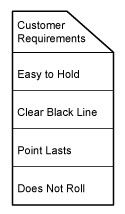
Step 2: Ranking the Requirements
This step involves asking customers to rate the importance of each requirement using a numerical ranking (from 1 to 10). The ranking is then entered into the HOQ as shown (Figure 4).
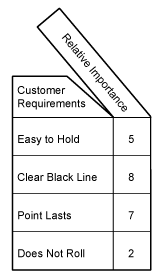
Step 3: Comparing Competitors
The benefit of this step is viewing situations where a company’s product is weaker than its competitors products as assessed by customers. This step also uncovers which specific requirements to focus on for improvement. To display this comparison, A represents the company and X, Y and Z the competitors (Figure 5).
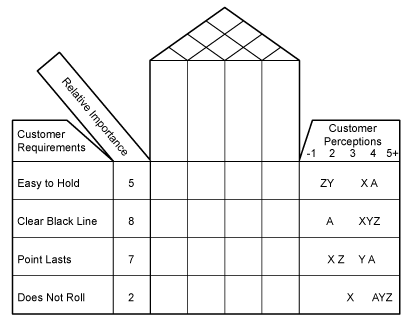
Step 4: Transforming Customer Requirements into Design Engineering Characteristics
This section of the HOQ is typically completed by the product design or engineering department. This information represents the design elements that correspond to customer-stated needs. This process transforms customer requirements into specific characteristics to be designed into the product (Figure 6).
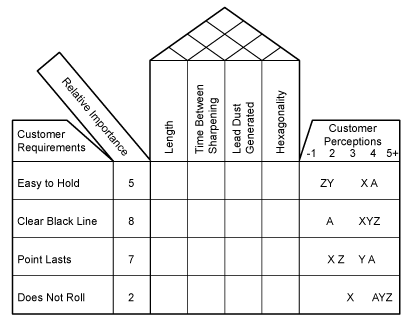
Step 5: Determining the Relationship Between Customer Requirements and Engineering Characteristics
Different indicators are used to depict the level of relationship between the customer requirements and the design requirements. In the example below, the following indicators are used (Figure 7):
- Strong relationship = 9 points (reflected on HOQ as =)
- Moderate relationship = 3 points (reflected on HOQ as O)
- Weak relationship = 1 point (reflected on HOQ as X)
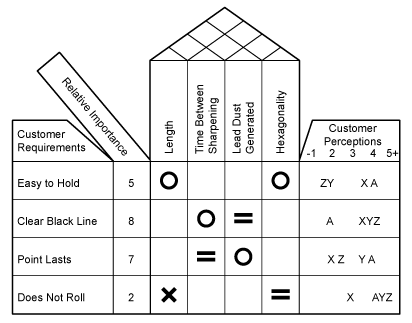
Step 6: Comparing Competitor Characteristics with Design Engineering Characteristics
In this step the engineering design characteristics are compared with those of the competitor products (Figure 8).
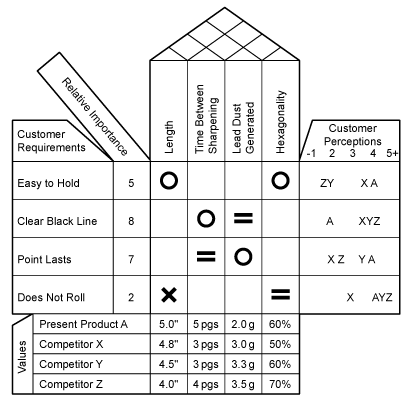
Step 7: Completing the HOQ Roof
Sometimes two product characteristics have a negative influence on each other. For example, when one is increased the other is decreased. This is recorded by placing an X in the roof of the HOQ chart where influence is anticipated (Figure 9).
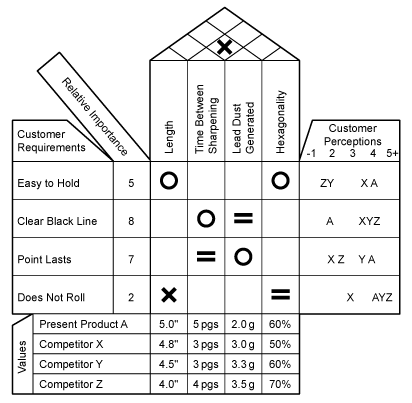
Step 8: Weighing the Engineering Characteristics
It is important to weigh the characteristics in order to identify the amount of importance each characteristic has on the level of customer satisfaction desired. The weight of each characteristic is derived using the following formula (Figure 10):
Wj = sum(Wi x dij), where
Wj = weight of characteristic j, Wi = rate of importance of requirement i (determined in Step 2) and dij = point of relationship between characteristic j and requirement i (determined in Step 5).
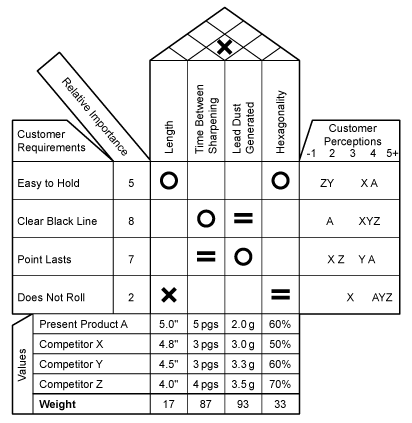
During this step, certain characteristics are revealed as key components for the design. These components satisfy a majority of the weighted customer satisfaction factors. For example, in this pencil case, the time between sharpening and the amount of lead dust generated are key components.
Step 9: Determining New Target Values for Characteristics
At this point in the completion of the HOQ, it is possible to set new target values for the product. These values are determined based on the following items (Figure 11):
- Relative importance (Step 2)
- Ranking of competitors relative to the satisfaction level of customers (Step 3)
- Competitor product value (Step 6)
- Component influences at the roof of house (Step 7)
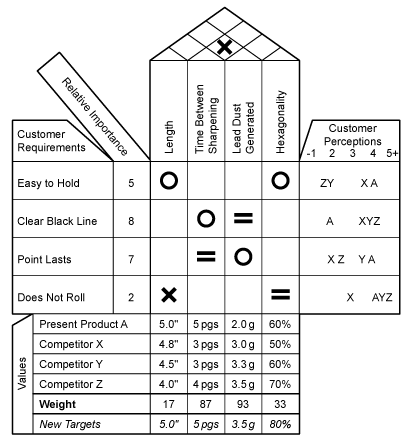
The new target values in the last row of the chart provide direction to set a strategy that matches the best competitor on the most important customer requirements. To achieve the goal, the design must consider the following challenges:
- Technical difficulty of designing and deploying the new product
- Cost of changing to a new design
- Negative relationship shown in the roof of the chart indicating potential difficulty in implementing specific requirements
Using the HOQ Results to Complete QFD
There are several uses of the HOQ results, including improving the process to gather VOC data, enhancing the design process and assessing competitor data more thoroughly. However the results are incorporated, they are not completely successful unless the remaining QFD cycles are also deployed: designing the product, designing the process and controlling the process.